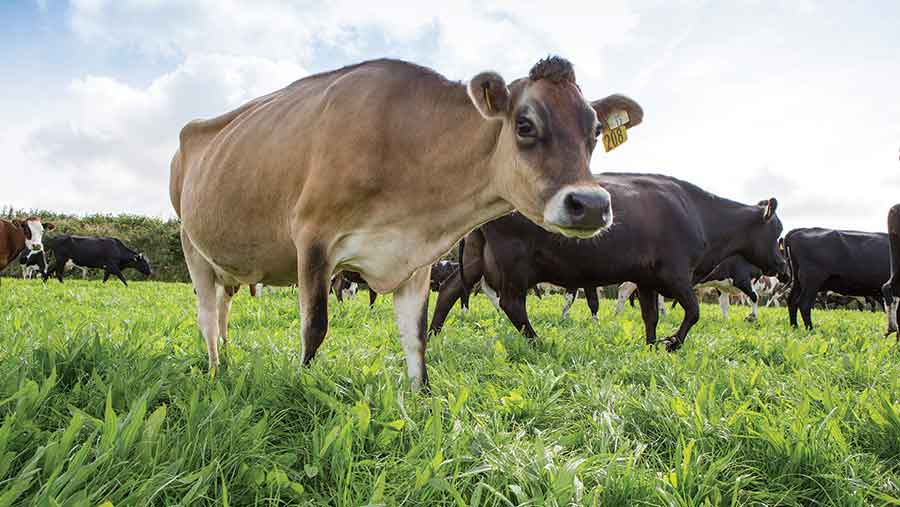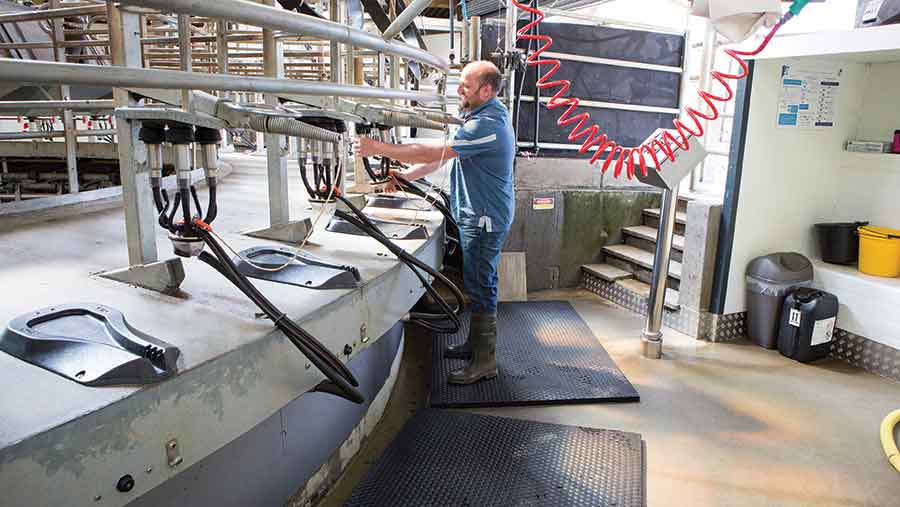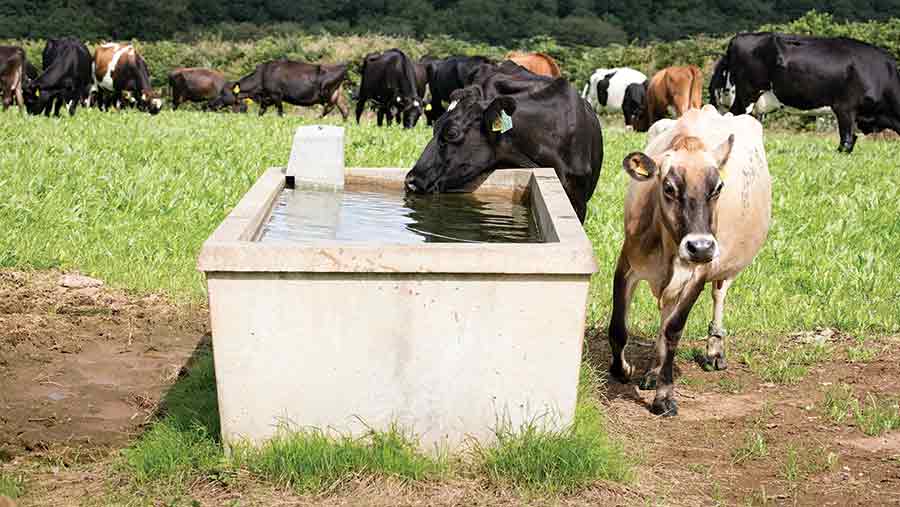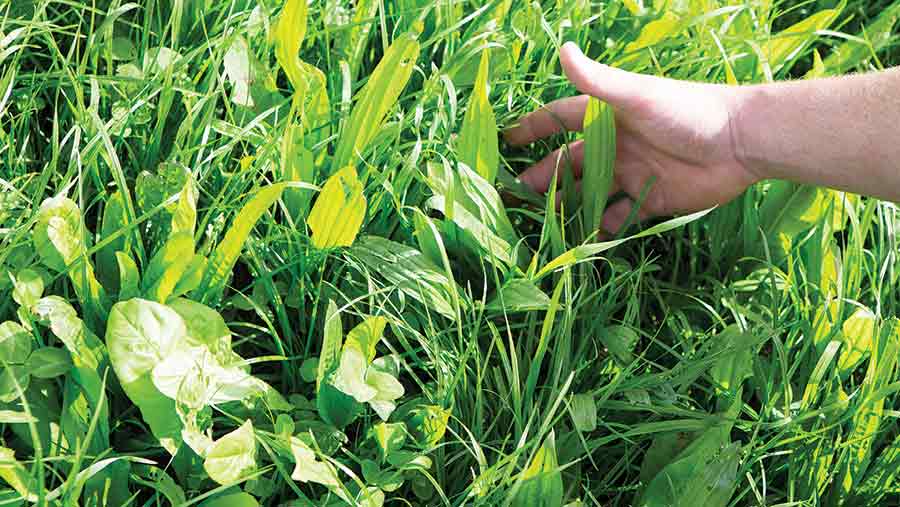Sheep-to-dairy conversion helps treble farm profits
 © Geoff Pagotto
© Geoff Pagotto The number of non-aligned dairy farmers with a spring in their step may have been thin on the ground in recent months, but for new entrant Dave Sanders the move from sheep to dairy has given him more than a few reasons to be upbeat.
In 2012, the business dispersed its 2,000-ewe Romney flock and converted to a 350-cow, entirely grass-based system, milking once a day.
Since then, profits have increased from 2p/kg of dry matter (DM) fed on the sheep system to 7.5p/kg DM. Work-life balance has also improved thanks to a 40% drop in labour requirements.
Farm stats
- 150ha grazing platform and 82ha support ground
- 3,000 litres a cow a year at 6.4% fat and 3.9% protein
- Calved 25 February 2016 over nine weeks
- Cows will calve later in 2017 on 10 March over eight weeks to better suit grass growth
- Fed baled silage at shoulders where necessary in collecting yard or at grass (no feed pad built)
- Housed when dry and calve inside in old suckler sheds
- Silage, straw and hay bought in for winter feeding when cows are dry
- <1% lameness
- Three cases of mastitis per 100 cows
- 7% empty rate
- 88% six-week in-calf rate
- 25% replacement rate
(All figures, three-years average)
See also: Read more about Dave Sander’s previous sheep enterprise
Admittedly, the milk price decline has made things more challenging in the past year, but the business’s three-year milk price average is still 3p/litre over budget (see “How the financials stack up”).
An average cost of production (COP) of 15p/litre also provides a margin, even at the current 22.5p/litre milk price on their Arla contract (based on the month of July and includes bonuses).
“This year has been tight, but we had a lot worse times running sheep,” says Mr Sanders, who farms in partnership with his father Bill at Norton Farm, Bodmin.
Forage focus
Up until 2012, sheep had been part of the farming business for two generations.
Although breed type and flock size had evolved over the years, management had always placed forage at its heart.
The emphasis on grass grew even stronger in later years, with the New Zealand Romney flock lambing outdoors and rotationally grazing fields, with no concentrate fed.
Mr Sanders adds: “All I’ve always been interested in is growing grass and converting it into cash. I want to turn kilos of dry matter into kilos of milk solids. And that was the same with the sheep – we were turning kilos of dry matter into kilos of meat and wool.”
With the spotlight placed firmly on managing a purely grass-based system, Mr Sanders has always used profit/kg of DM fed as a key performance indicator.
It was this handle on profits that led him to re-evaluate what he was doing after a trip to New Zealand in 2009.
“I went to places where some of our sheep genetics had come from and three-quarters of them had converted to dairy. I knew I was making a profit of 2p/kg DM and dairy farmers out there were achieving 7-9p,” he explains.
On his return to England, he sat down with his father to discuss the business’s plans for the future. With his father approaching retirement, they decided there was more scope for profit and less labour requirements with a low-cost dairy system. The approaching end of quotas acted as another push.

Bill and Dave Sanders © Geoff Pagotto
Why once-a-day milking?
After visiting a number of once- and twice-a-day milking systems and crunching the numbers, the Sanders decided once-a-day milking would be the best route due to its simplicity.
Mr Sanders explains: “We thought once-a-day milking was more sustainable, more consistent and easier on cows than doing it twice a day. In a good year, milking twice a day is probably as good, if not better. But on average, once-a-day is always better. And coming from sheep, it made sense as there was less milking.”

© Geoff Pagotto
Budgets also predicted that twice-a-day milking would add 6p/litre to COP, while once-a-day milking would lead to higher milk solids (MS) percentages, which would be beneficial to their milk contract.
Dave Sander’s top tips for new entrants
- Whatever you chose to do, it has to be sustainable, repeatable and low cost.
- Budget realistically.
- Compare systems and talk to others – you learn the most from talking to farmers.
The conversion
So in March 2013, the Sanders purchased 400 yearling heifers using the income from the sale of the flock. They chose New Zealand Jersey cross-breds, opting for a higher percentage of Jersey genetics for optimum grazing efficiency.
The ultimate aim is to produce a similar amount of MS a head as animal weight – with a rough target of 340kg of MS a head and a herd average cow weight of about 380-400kg.
Initial budgets took into account the fact heifers would produce 40% less in their first year compared with second and third calvers.
Mr Sanders says those herds producing an average 320kg of MS a cow are relying on a lot of cows in their sixth or seventh lactation. However, having visited a number of once-a-day milking systems with cows in their teens, he believes cow longevity is one of the biggest benefits of this low-pressure system.
He adds: “Depreciation is one of the biggest costs of farming – if cows last longer, the people will as well.”
He predicts the herd will hit targets by 2023, taking into account a 25% cull rate. As the herd is on 60-day testing, this includes about 30 head a year lost to TB, as well as cows generally not suited to once-a-day milking.
In terms of costs, the highest spend has been on infrastructure, with a bank loan used to put in a 40-point rotary parlour, yard, tracks, fencing and also to reseed pasture. A borehole, 63mm ring main and trough in each paddock have also been installed.

© Geoff Pagotto
About 60% of 1,500m of tracks have been put down to stone and the remaining kept as basic earth tracks. The small cow size and low traffic due to reduced milking frequency means they can get away with earth tracks.
Grazing
Where possible paddocks have been split into 4ha sections. A long-running five-yearly reseeding policy has also been continued. Up until this year, this has involved selecting intermediate and late-heading diploid perennial ryegrasses, white clover, timothy and chicory mixes.
“The cows like chicory and if there’s a dry spell it grows really well. It also brings diversity and the deep taproot helps with compaction and brings up minerals,” Mr Sanders explains.
In the past 12 months, he has also chosen to introduce herbal grazing leys, including birdsfoot trefoil, red and white clover, timothy, cocksfoot, perennial ryegrass, plantain and chicory.

© Geoff Pagotto
Mr Sanders believes the 21-day round at peak growth stops the leys from getting too far ahead. Bales are also taken as a management tool where necessary.
This higher-quality silage is then fed at the shoulders of the year to bridge any gap in grass growth, with no concentrate fed at any time.
Mr Sanders says he is “not obsessed with residuals” and having used a grass plate meter for four years with the sheep, now moves cattle by eye. Entry grass heights and residuals will then be gauged depending on individual field type.
Overall he remains entirely convinced the move to dairy was well worth it. “I’m very pleased we converted. It’s cut our workload 40% and the whole system seems to be working really simply. We’re getting three times the return for p/kg DM and there’s no stress of marketing (versus the sheep),” he says.
Mr Sanders attributes the reduced workload to less time needed for handling and weighing stock, with most of the work now completed after morning milking.
“I have no regrets. The only regret is we didn’t go dairy farming quicker. But I wouldn’t have wanted to buy quota to lose it. Perhaps the low milk price is like buying quota for new entrants.”
How the financials stack up
Cost of conversion: £1,000 a cow (bank loan to build new parlour, yard, tracks, fencing, troughs and reseeding. Loan payback: 15 years)
Milk price
Budgeted: 24p/litre + 3p/litre bonuses for high solids produced on once-a-day system
Actual: 30.76p/litre total average over three years (including bonuses)
January 2016 to December 2016 predicted: Average 22.5p/litre total
Cost of production (minus rent and finance): 15p/litre
|
Profit (before tax and capital repayments) |
|
|
Sheep (seven-year average) |
Dairy (three-year average) |
|
2p profit/kg DM fed |
7.5p profit/kg DM fed |
Milk solids
First year (2014): 213kg MS a cow a year (budgeted 210kg MS a cow) – 39.8p/litre milk price
Second year (2015): 268kg MS a cow (budgeted 260kg MS a cow) -30p/litre milk price
This year (2016): 280kg MS a cow budgeted – 22.5p/litre milk price
Long term target: 340kg MS a cow
Milk price includes bonuses)
